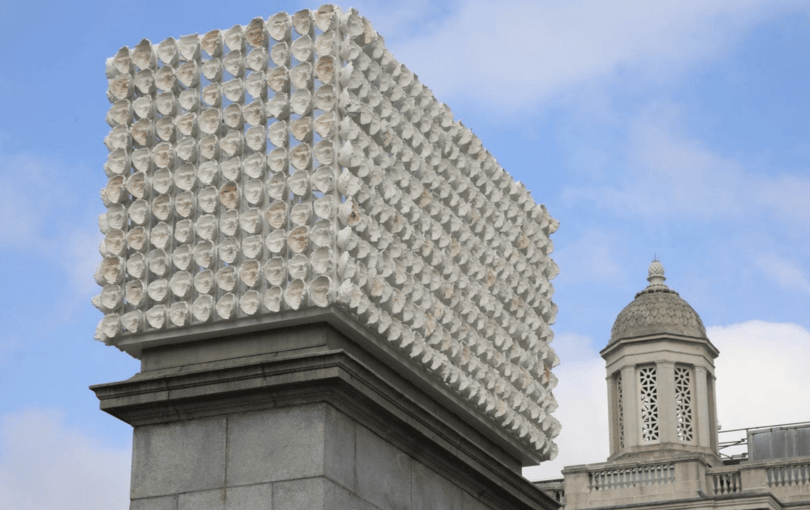Abortion, Gender Ideology
Transgenderism has taken over the UK’s iconic Trafalgar Square
As I noted last year, you can learn much about a culture by who it honors. Our flags, our statues, our memorials – these things tell us who we honor, what our values are, and ultimately who we are. That is why the culture wars over symbols that may seem unimportant are actually a symptom of a much deeper disease. The “statue wars” and battles over rainbow flags are fundamentally identitarian, as the sexual revolutionaries have long realized.
In the United Kingdom, Trafalgar Square in the City of Westminster, central London, is one of the most iconic spaces in the English capital. Named for the victory of Lord Horatio Nelson over the Napoleonic fleet in 1805, it features Nelson’s Column, which soars 18 feet high over the square, and is surrounded by four “plinths.” Three of them feature statues of King George VI, Henry Havelock, and Charles Napier.
The plinths are intended to honor the U.K.’s heritage. The plaque on Havelock’s plinth reads: “To Major General Sir Henry Havelock KCB and his brave companions in arms during the campaign in India 1857. ‘Soldiers! Your labours, your privations, your sufferings and your valour, will not be forgotten by a grateful country.’ H. Havelock.” A recent BBC article, predictably, dismisses both Havelock and Napier as “two 19th Century military figures instrumental in Britain’s control of India.”
The fourth plinth features rotating artworks. Currently, it hosts an art installation put up in September called “Mil Vices un Instante,” or “A Thousand Times in an Instant.” According to the BBC, “the sculpture was created by Mexican artist Teresa Margolles and features the faces of 726 trans, non-binary and gender non-conforming people.” The sculpture is a massive block of faces that resemble death masks; indeed, the BBC describes the display as “arranged around the plinth in the form of a tzompantli, a skull rack that featured in Mesoamerican civilisations, used to display the remains of war captives or sacrificial victims.”
Margolles created the sculpture in Mexico City and Juárez, Mexico, and London. She worked with LGBT groups in both Mexico and the U.K., including QUEERCIRCLE and Micro Rainbow, and London’s government website stated that the casts were created “by applying plaster directly onto the faces of participants, meaning that as well as recording their features the plaster is infused with their hair and skin cells.” The display is massive, dwarfing passersby and surrounded by some of the U.K.’s most recognizable landmarks. It will remain there for two years
Does this matter? Casual readers might be tempted to view this as a tempest in a teapot. But that reaction fails to understand what the sexual revolutionaries have long understood: that symbolic victories are real victories, and they matter. One media outlet referred to the installation as “an act of defiance.” Another called it a “tribute to the global trans community.” A third dubbed it a “monument to trans and nonbinary life.” The transgender movement, especially in the United Kingdom, is in a fierce fight to establish that terms like “transgender” and “nonbinary” are reflections of reality.
The trans movement seeks to force recognition of concepts “transgender,” the idea that a man or woman, boy or girl can be “born in the wrong body,” and “nonbinary,” the idea that people can exist outside of the male-female sex binary. They have sought to do so through hate crime laws, through legislation, and through social pressure. For years, the mainstream media and most political parties have assisted them in these efforts. Recently, with the pushback of social conservatives, feminist groups, and high-profile opponents such as J.K. Rowling, the transgender movement in the U.K. has lost ground.
That is precisely why the ground now occupied by “A Thousand Times in an Instant” is so significant – especially because it is located in Trafalgar Square. The massive display announces to the millions of people who pour through central London each year that the debate is over; that “transgender” and “nonbinary” are indisputable concepts; that alongside Horatio Nelson, George VI, Charles Napier, and Henry Havelock, these figures – some of them prostitutes – are worth of national recognition in one of London’s most coveted pieces of real estate.
Yes, this is a “culture war,” as some try to say dismissively. That is because it is a war over what the culture actually is – and who it honors. We should understand that as well as the LGBT movement does. When trans-identifying prostitutes are elevated to the same level as kings and military heroes of old, it tells us something about who we have become.








